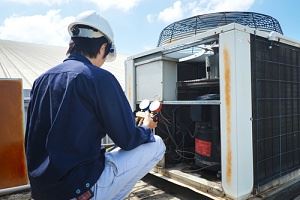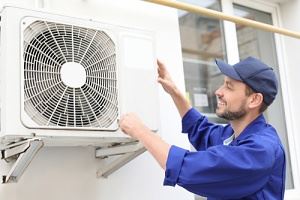Presidential Heating & Air Conditioning
Gaithersburg HVAC Contractors
Share
Share on FacebookTweet
Tweet this0Share
Share on LinkedIn0 shares on LinkedInA split system air conditioner is a generic term that describes an air conditioning system that has an outdoor component and an indoor component. The indoor and outdoor components are linked together by a conduit that houses a power cable, refrigerant tubing, suction tubing, and a condensate drain. Read more about what a split system air conditioner is below.
Split System Air Conditioners Explained
 As the name implies, split system air conditioners have two primary components, one indoor and one outdoor. The indoor component, which is the air-handling unit, contains a cooling coil, a long blower, and an air filter. It is usually mounted on a wall inside the room or in the ceiling. The outdoor component consists of the compressor, condenser cooling fan, condenser coil, and the expansion coil or capillary tubing.
As the name implies, split system air conditioners have two primary components, one indoor and one outdoor. The indoor component, which is the air-handling unit, contains a cooling coil, a long blower, and an air filter. It is usually mounted on a wall inside the room or in the ceiling. The outdoor component consists of the compressor, condenser cooling fan, condenser coil, and the expansion coil or capillary tubing.
A split air conditioner works by drawing air through a membrane that is refrigerated by a coolant. These coolants are eco-friendly and do not deplete the ozone. Like most air conditioning systems, the cost of a split air conditioner system depends on a number of factors, such as the size of your space, the amount of insulation, the energy-efficiency of your windows, and how many BTUs you need for optimal use.
How a Split System Differs from Other Popular Air Conditioning Systems
The primary difference between a split system and a traditional central air system is the split system requires no ductwork. Not only does this save on new installations, but it also provides better operating efficiency because ductwork is a significant source of energy loss. Without ductwork, your split system delivers the cool air you need directly into your room.
A split system also differs from a window unit. In a window unit, all of the mechanics needed for cooling are in a single unit. As a result, the window units are noisy and prone to leakage if not adequately sealed. They are also unsightly, and as a result, are often prohibited in many newer residential communities.
Benefits and Advantages of a Split Air Conditioner
Split systems offer homeowners a number of benefits, including:
Ideal If Ductwork Is an Issue
One primary advantage is a split system provides efficient cooling in homes and office spaces without using ductwork. In older homes, ductwork was not installed like it is in modern homes. In addition, many older homes do not have space for new ductwork to be installed. If you have an older home that needs to be retrofitted with air conditioning, a split system may be the answer for you.
Ideal for Small Spaces
Split system air conditioners take up very little space for the comfort they provide. Accordingly, they are great for small spaces. In addition, their small size does not compromise the cooling power they provide. A single outdoor compressor/condenser can support up to four indoor air-handler units. That means a single outdoor unit can cool up to four rooms.
Highly Energy Efficient
On-demand heating and cooling will save you money. Each zone is controlled with its own thermostat, and you only pay to cool the space when it is occupied. Also, the split system provides heating as well as cooling, so you can save the expense of a heating system if you live in a climate with milder winters. Although the initial cost of a split system is more than you would pay for a window unit and possibly a traditional central air system, you will save money in the long run because they operate so efficiently and last a long time.
In addition, the absence of ductwork means you can avoid the energy losses associated with ductwork of central air systems. When air conditioning ducts are in an uncooled space such as an attic, they can account for losses of more than 30% of the energy consumption used by the system. With a split system, you will not have to pay for that wasted energy.
Easy to Install
The installation of a split system is fairly straightforward for trained HVAC professionals. The connection between the indoor and outdoor units requires no more than a three-inch hole through a wall for the conduit. In most cases, the outdoor unit can be located up to 50 feet away from the indoor component. With that flexibility, you should be able to cool rooms on the front side of your home or building and locate the outdoor component in an inconspicuous location outside.
Installation is much less expensive than the cost of installing a traditional central air system. Keep in mind that a homeowner’s cooling system is often one of the most expensive mechanical systems of your home. Therefore, proper installation is important to ensure you get the most out of your investment. It may also be necessary to keep a warranty effective.
Quiet Operation
Traditional central air is noisy because the mechanical components have to be large enough to circulate the air through all of the ductwork. The ductwork itself may rattle and vibrate. Window units are noisy, too, because the compressor and the fan are in the same unit. In the split system, however, the noisiest components are located outside, and no ductwork is needed.
Long Lifespan
The efficiency of a split system means it does not have to work as hard as a traditional central air system to cool your space. You do not have to cool your entire home just to cool the rooms you are using.
Maximize the life of your system by getting the right size for your space. A split system can cool a room down to 59 degrees and heat a room up to 90 degrees. Systems are available that can supply from 9,000 BTUs to 36,000 BTUs. An expert HVAC technician can help you buy the correct-size unit for your needs. A properly sized system that is professionally installed will ensure optimal comfort and maximize the life of the components.
Contact the HVAC Experts at Presidential Heat and Air
A split system air conditioner may be ideal for your needs. With all of the benefits they offer, they are worth some serious consideration. For more information about the split system and its installation, speak with the HVAC professionals at Presidential Heat and Air.


